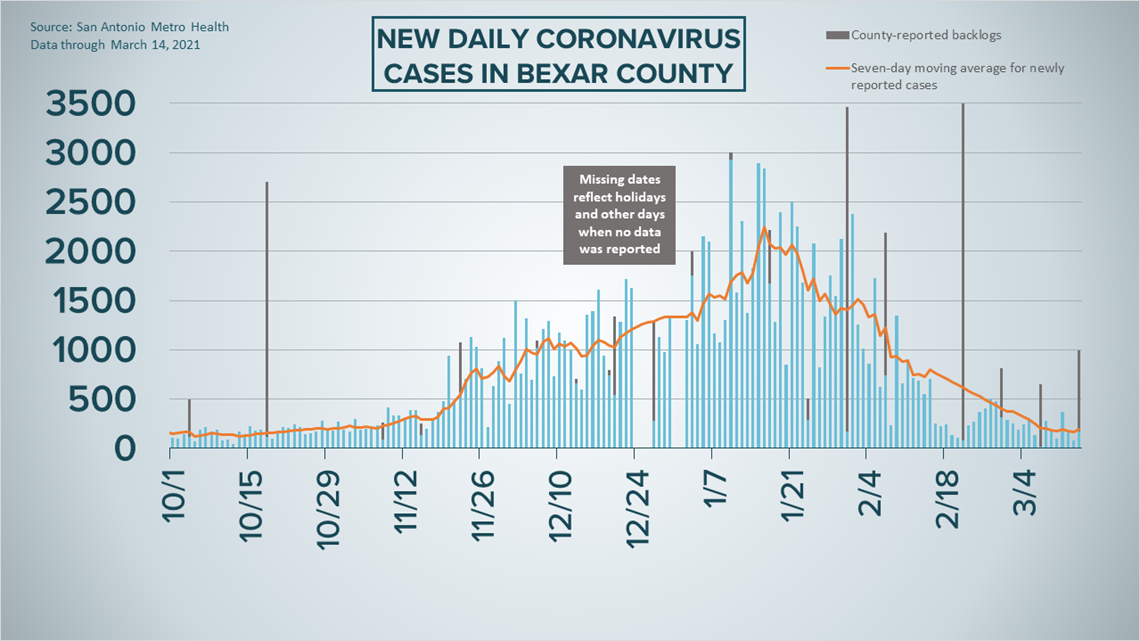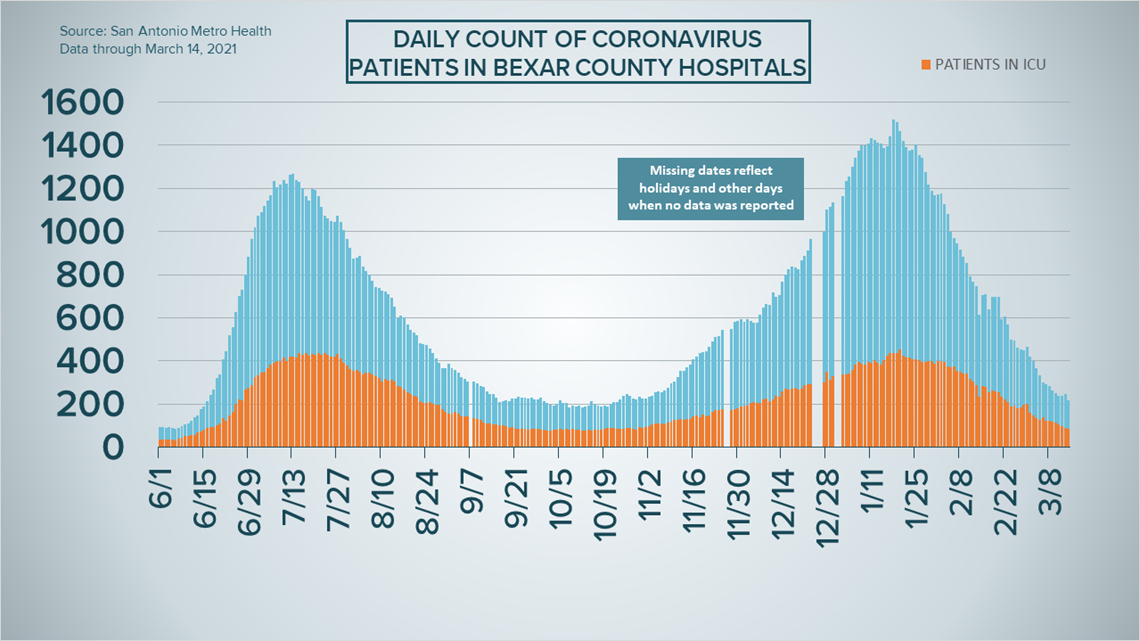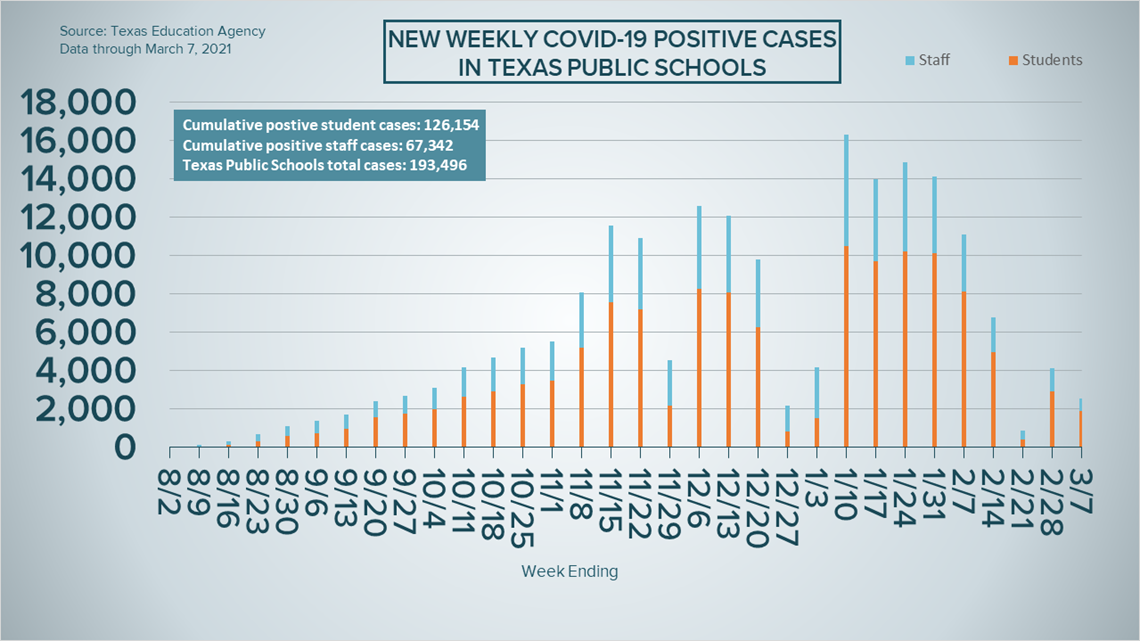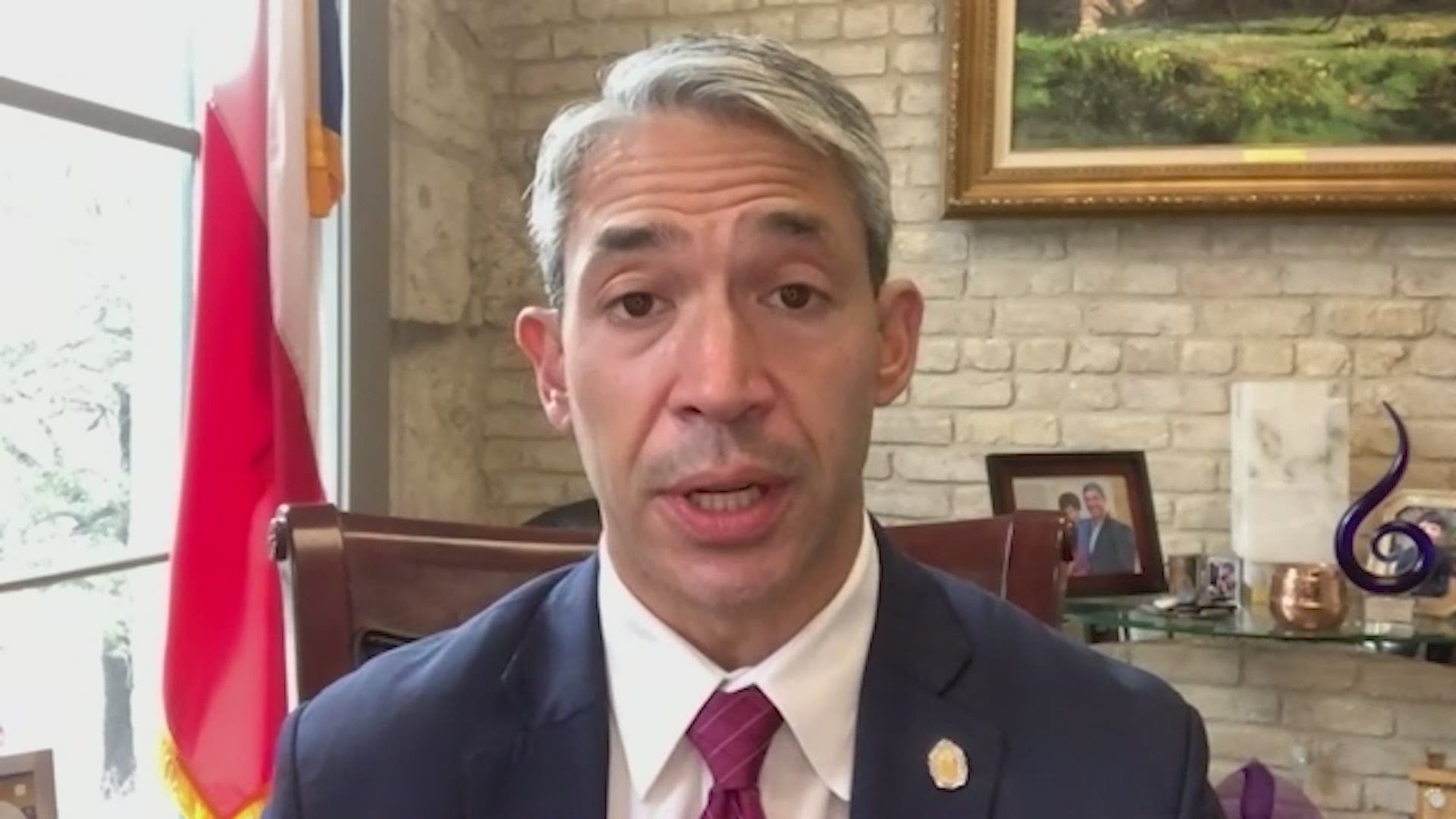SAN ANTONIO — We're tracking the latest numbers from the coronavirus pandemic in San Antonio and across Texas. Here are the latest numbers reported by Bexar and surrounding counties:
- Bexar County: On Sunday, 171 new cases were reported along with a backlog of 820 cases. The total number of cases in Bexar County rose to 200,664. Three new deaths were also reported, along with a backlog of 119 deaths. The local death toll from virus complications is now 2,990.
- Hays County: On Friday, officials reported 17 new cases in the county and one additional COVID-related fatality. There is now a total of 16,668 lab-confirmed local cases, while the death toll increased to 232. Officials estimate 15,990 residents have recovered, while 446 are still ill with the virus.
- Comal County: Officials reported 39 new cases on Friday, along with no additional virus-related deaths. As of Friday, 9,419 total COVID-19 cases have been reported, including 4,955 confirmed and 4,443 probable cases, while 298 county residents have died due to COVID-19 complications.
More county case information is available through the Texas Department of Health Services COVID-19 dashboard.
How Bexar County is trending
We've tracked how many coronavirus cases have been confirmed in Bexar County from the time officials began reporting cases in March 2020. The graphic below shows the number of cases since June and charts those daily case numbers along a 7-day moving average to provide a more accurate picture of the overall coronavirus case curve in our area and the direction we're trending amid the pandemic.
On Sunday, Metro Health updated its online coronavirus-tracking dashboards to reflect 171 new cases in Bexar County. County officials also reported a backlog of 820 cases, bringing the total number of local cases to 200,664.
Health authorities also reported three more virus-related deaths in the community, as well as a backlog of 119 deaths that occurred between December 12, 2020 and February 25, 2021. In all, 2,990 Bexar County residents have died from virus complications.


Local hospitalizations dropped to 216 COVID-19 patients receiving treatment at area facilities, which is 32 fewer than Saturday. Of those 216, 52 patients are on ventilators and 86 are in intensive care; both those figures are down from Saturday.


Coronavirus in Texas
The total number of novel coronavirus cases in the state since the pandemic began grew by 2,628 on Sunday, according to the Texas Department of State Health Services. That total includes 2,004 new confirmed cases, 343 new probable cases, and a backlog of 281 cases. More details can be found on this page.
Sunday's figures bring the total number of Texans diagnosed with COVID-19 to more than 2.718 million.


Meanwhile, state health authorities reported an additional 69 deaths from coronavirus complications in Texas. In all, 45,543 Texans have died from COVID-19 complications.
The number of concurrent hospitalizations across the state has decreased for the fifth day in a row, this time by 126 to 4,093 COVID-19 patients receiving treatment for their symptoms across the state, as of Sunday. The last time the figure was that low was October 12.
The state, meanwhile, estimates that about 2.556 million Texans have recovered, while 112,819 Texans remain ill with COVID-19.
The latest update from the Texas Education Agency showed that there have been at least 193,496 cumulative cases among staff and students on Texas public school campuses through March 7. That number comprises 126,154 positive student cases and 67,342 staff cases. More information can be found here.


The TEA typically releases new data on school cases on Fridays.
Latest Coronavirus Headlines
- Candlelight vigil held to honor those who died since pandemic began
- Texas has new incentive to expand Medicaid with COVID relief package that Democrats passed in Congress
- Fauci: Trump should urge his followers to get vaccinated
- Spring Breakers pack Galveston on first weekend of Texas reopening
- Survivors struggle as scientists race to solve COVID-19 mystery
- Third stimulus check: Track the status of your payment
- Yo-Yo Ma transforms COVID vaccine waiting period into surprise concert
Coronavirus symptoms
The symptoms of coronavirus can be similar to the flu or a bad cold. Symptoms include fever or chills, cough, shortness of breath or difficulty breathing, fatigue, muscle or body aches, headache, new loss of taste or smell sore throat, congestion or runny nose, nausea or vomiting, and diarrhea, according to the Centers for Disease Control.
Most healthy people will have mild symptoms. A study of more than 72,000 patients by the Centers for Disease Control in China showed 80 percent of the cases there were mild.
But infections can cause pneumonia, severe acute respiratory syndrome, kidney failure, and even death, according to the World Health Organization. Older people with underlying health conditions are most at risk.
Experts determined there was consistent evidence these conditions increase a person's risk, regardless of age:
- Chronic kidney disease
- COPD (chronic obstructive pulmonary disease)
- Obesity (BMI of 30 or higher)
- Immunocompromised state (weakened immune system) from solid organ transplant
- Serious heart conditions, such as heart failure, coronary artery disease, or cardiomyopathies
- Sickle cell disease
- Type 2 diabetes
- The CDC believes symptoms may appear anywhere from two to 14 days after being exposed.
Human coronaviruses are usually spread...
- Between people who are in close contact with one another (within about 6 feet).
- Through respiratory droplets produced when an infected person coughs, sneezes or talks. These droplets can land in the mouths or noses of people who are nearby or possibly be inhaled into the lungs.
- Some recent studies have suggested that COVID-19 may be spread by people who are not showing symptoms.
Help stop the spread of coronavirus
- Stay home when you are sick.
- Eat and sleep separately from your family members
- Use different utensils and dishes
- Cover your cough or sneeze with your arm, not your hand.
- If you use a tissue, throw it in the trash.
Find a Testing Location
City officials recommend getting a COVID-19 test if you experience fever or chills, cough, shortness of breath or difficulty breathing, fatigue, muscle or body aches, headache, new loss of taste or smell, sore throat, congestion or runny nose, nausea or vomiting, or diarrhea.
Here's a Testing Sites Locator to help you find the testing location closest to you in San Antonio.

